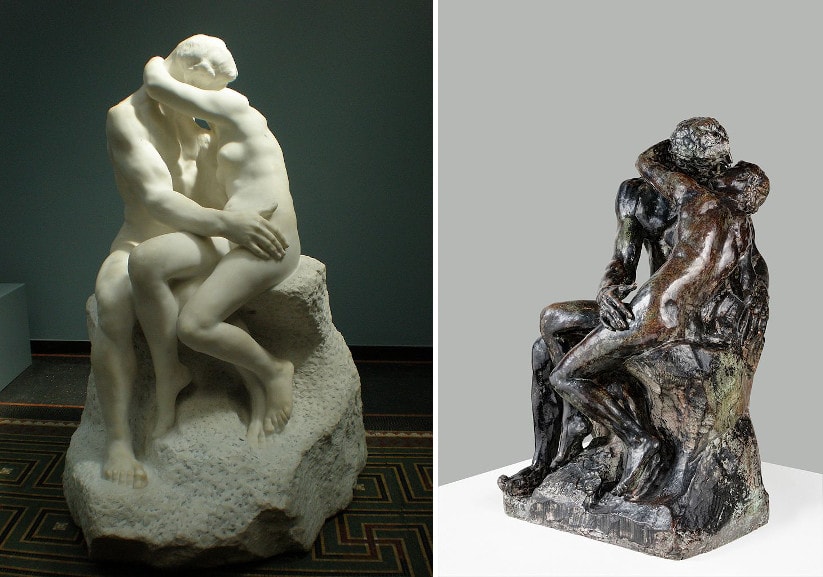The Tangled and Controversial History of Rodin's The Kiss
The very look at the history of modern sculpture implies the name of Auguste Rodin. Although classically trained, the notable French sculptor was among the first to embrace an innovative and far-naturalistic approach to sculpting, unlike the tradition that was at large centered on allegory and mythology. Rodin was one of a kind art figure widely recognized for his epic works such as The Thinker, Monument to Balzac, and The Kiss.
The tantalizing depiction of the lovers entwined was made in marble in 1882. Initially, it originated as part of Rodin's other monumental work, the bronze portal, The Gates of Hell, commissioned for a museum in Paris. In the first place, Rodin's sculpture was titled Francesca da Rimini, as it is based on the 13th-century Italian noblewoman featured in Dante's Inferno who falls in love with her husband Giovanni Malatesta's younger brother Paolo. Under the impression of the mythical story of Lancelot and Guinevere, the couple falls in love, but shortly after, they are discovered and killed by Giovanni. Within the sculpture, Paolo is depicted holding the book while his and Francesca's lips do not touch, suggesting the moment they were captured.
After Rodin's piece was shown to the public, the critics suggested the marble sculpture should be named The Kiss. At the same time, many found it controversial as it showed what was back then seen as explicit content. In 1893, a bronze version of the sculpture was exhibited at the World's Columbian Exposition in Chicago and was practically censored and put in a secluded room with admission only by personal application.

The Kiss Commissions
In 1888, the French government commissioned the first large-scale marble version of The Kiss from Rodin for the 1889 Exposition Universelle in Paris. However, the sculpture was publicly displayed for the first time in the Salon de la Société Nationale des Beaux-Arts ten years later. Despite the controversy, The Kiss gained popularity, and the company Barbedienne offered the artist a contract to produce a limited number of small copies in bronze.
In 1900, the grand statue was relocated to the Musée du Luxembourg and, in 1918, to its permanent location, the Musée Rodin. The same year, Rodin also made a copy of the sculpture for an eccentric American collector and queer man, Edward Perry Warren, who lived in England with his collection of Greek antiquities and his lover John Marshall. The artist William Rothenstein recommended the piece to Warren, but the work had been commissioned by the French government and was not available for sale. Instead, Rodin offered to make a copy without wavering the price, and the contract for the commission included that "the genitals of the man must be completed" in the Classical Greek tradition.
In 1904, the sculpture arrived at Warren's estate in Lewes and was placed in the stables, where it remained for a decade. In 1914, Rodin's The Kiss was loaned to the Lewes town council and put on public display. The display horrified the local residents due to its erotic nature, raising concerns that it may encourage the passion of the large number of soldiers who were located in the town at that time. The campaign was successful, and the sculpture was draped and hidden from public view. In 1917, it was returned to Warren's residence, where it remained in the stable until his death in 1928. The Tate Gallery in London eventually bought Rodin's The Kiss in 1955.
The third replica was commissioned by Carl Jacobsen in 1900 for his museum in Copenhagen. It was produced in 1903 and became part of the Ny Carlsberg Glyptotek collection. The three larger marble versions were exhibited together at the Musée d'Orsay in Paris in 1995.
A fourth copy was produced after Rodin's death by sculptor Henri-Léon Gréber for the Rodin Museum of Philadelphia. A plaster cast is held at the Museo Nacional de Bellas Artes of Buenos Aires.

The Iconic Status of Auguste Rodin's The Kiss
Throughout the 20th century, Rodin's masterpiece was often referred to in popular culture. The British band Yes was inspired by The Kiss for their song Turn Of The Century, found on the 1977 release of Going for the One. The notorious comedian and founding member of Monty Python, Terry Gilliam, used the statue in Monty Python's Flying Circus animation. Interestingly so, the Lewes-based Harvey's Brewery made a beer named Kiss, featuring the iconic work of art on its label.
In 2003, with the permission of the Tate Britain gallery, Cornelia Parker intervened in Rodin's The Kiss (1886) by wrapping the sculpture in a mile of string. In doing so, the artist referred to Marcel Duchamp's 1942 performative usage of the same length of string to develop a web inside an exhibition space. Although the intervention was fully supported by the gallery, many visitors saw it as offensive to the original artwork. This dissatisfaction culminated with the cutting of the string by Stuckist Piers Butler, who was surrounded by the couples engaging in live kissing.
Looking from a contemporary stance, there's nothing provocative about Rodin's The Kiss as it features a tasteful interpretation of desire - definitely just a kiss, not an orgasm. However, the work is still a subject of a range of interpretations of Rodin's intention, apparently making it a relevant work of art widely celebrated for timeless beauty and outstanding craftsmanship.
Featured image: Auguste Rodin - The Kiss, detail, circa 1881-1882. Rodin Museum in Paris Image via Creative Commons.
Can We Help?
Have a question or a technical issue? Want to learn more about our services to art dealers? Let us know and you'll hear from us within the next 24 hours.
